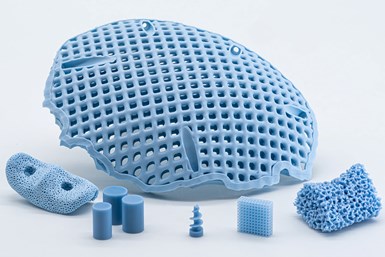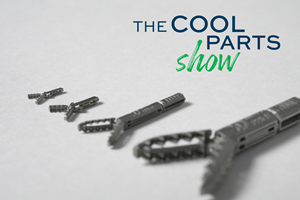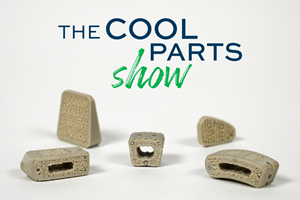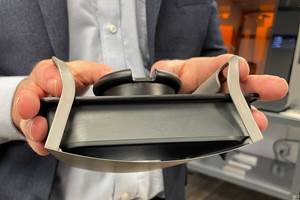Lithoz, Himed Partner for Research on 3D-Printable Medical-Grade Bioceramics
This collaboration is designed to help grow the range of biocompatible materials suitable for a future that includes highly customized, patient-specific medical solutions that can be printed on demand.
Share
Read Next
LithaBone HA 480 is a greatly improved human bone-like ceramic material which can be used to create distinctly blue complex parts. Photo Credit: Lithoz
Lithoz, a provider of ceramic 3D printing, and New York-based biomaterials manufacturer Himed have signed strategic research partnership agreement to further accelerate the development of medical-grade bioceramics. Focusing on implants using biocompatible calcium phosphates, the cooperation is designed to better meet the strongly increasing demand for innovative 3D-printable bioceramic feedstocks.
As part of the joint effort, Himed has acquired a Lithoz CeraFab S65 Medical Printer to explore novel integrations of its leading calcium phosphate biomaterials with Lithoz’s proprietary ceramic binder LithaBone HA 480.
After searching for a strategic partner in the United States to better access the potential of top-level surgery specialists there, this partnership forms the next logical step in the large-scale commercialization of this very specific 3D printing product. The partners say their collaboration will also help form an intercontinental pool of top researchers driving 3D-printable bioceramics to the next level. Partnering with Himed enables Lithoz to explore the potentials of other CaP phases within the sophisticated biomimetic forms its printers can make.
Thanks to its properties (such as excellent biocompatibility and osteoconductivity), the tricalcium phosphate or hydroxy apatite-based LithaBone medical ceramics have proven to be an attractive alternative to metals used in human surgery. Lithoz has also received numerous innovation study requests involving these bioceramics, as the precision and design flexibility of Lithoz LCM technology offers potential for innovation when it comes to lattice structures and porostities achieving the desired ideal level of osteoconductivity.
First-phase research will occur at Lithoz’s U.S. location in Troy, New York, this summer by a joint team of materials scientists. Himed will install a new Lithoz CeraFab S65 printer at their 25,000 ft.2 facility in Long Island early this fall, enabling the company to more rapidly experiment on-site and run analytical testing at its in-house laboratory.
The addition of a CeraFab S65 at Himed also broadens its R&D service offerings, adding rapid prototyping of different forms for clients who contract with Himed to conduct unique biomaterials research.
“Himed understands CaP optimization and how to scale it for a growing market. We’ve refined many calcium phosphates to strengthen their healing potential, but most of these were targeted toward surface coatings on traditionally manufactured titanium implants,” says Dana Barnard, Himed CEO. “Lithoz’s remarkable 3D printing technology allows a whole new direction for our products, in which we can use CaP to its greatest advantage — as a biomimetic material within the implant structure itself that can be replaced by a person’s own natural bone over time.”
Ultimately, both companies believe there is still much to discover about developing CaP materials to augment the performance of 3D-printed implantable forms. “This is definitely a big milestone for our partnership, and just a first starting point for a mutual beneficial collaboration for additive manufacturing of bone replacement,” says Dr. Johannes Homa, Lithoz CEO.
This strategic partnership represents a first step in growing the range of biocompatible materials suitable for a future that includes highly customized, patient-specific medical solutions that can be printed on demand. Over the last 30 years, calcium phosphates such as hydroxy apatite have gained widespread use in implantable devices, bone putties and grafting materials for their similarity to natural bone, and can aid the organic regrowth of hard tissue at the implantation site. Since 1991, Himed has collaborated with different medical implant manufacturers to develop and optimize various CaP powders and surface treatments for osseointegration. The partnership with Lithoz, however, enables new opportunities for Himed in the medical additive manufacturing market beyond bioactive surface treatments and postprocessing of implants.
- Learn more about Lithoz offering improved ceramic material for 3D-printed bone replacements. The company says the 3D printed, patient-specific parts made of hydroxyapatite are well suited for bone replacements in the medical and dental field.
- Read about Lithoz’s 3D printed ceramics serving as both bone graft and support. Bioceramics including tricalcium phosphate and zirconia have been used to replace and stabilize human bone in reconstructive surgeries. Now, 3D printing brings customization and new design opportunities to these medical devices.
Related Content
Micro Robot Gripper 3D Printed All at Once, No Assembly Required: The Cool Parts Show #59
Fine control over laser powder bed fusion achieves precise spacing between adjoining moving surfaces. The Cool Parts Show looks at micro 3D printing of metal for moving components made in one piece.
Read MoreFDA-Approved Spine Implant Made with PEEK: The Cool Parts Show #63
Curiteva now manufactures these cervical spine implants using an unusual 3D printing method: fused strand deposition. Learn how the process works and why it’s a good pairing with PEEK in this episode of The Cool Parts Show.
Read MoreNew Zeda Additive Manufacturing Factory in Ohio Will Serve Medical, Military and Aerospace Production
Site providing laser powder bed fusion as well as machining and other postprocessing will open in late 2023, and will employ over 100. Chief technology officer Greg Morris sees economic and personnel advantages of serving different markets from a single AM facility.
Read MoreFormlabs Part Removal Mechanism Enables Lights-Out Production
A build platform overcoming the need for manual part removal enables automated part handling, and therefore continuous production from one build cycle to the next.
Read MoreRead Next
At General Atomics, Do Unmanned Aerial Systems Reveal the Future of Aircraft Manufacturing?
The maker of the Predator and SkyGuardian remote aircraft can implement additive manufacturing more rapidly and widely than the makers of other types of planes. The role of 3D printing in current and future UAS components hints at how far AM can go to save cost and time in aircraft production and design.
Read MoreHybrid Additive Manufacturing Machine Tools Continue to Make Gains (Includes Video)
The hybrid machine tool is an idea that continues to advance. Two important developments of recent years expand the possibilities for this platform.
Read More4 Ways the Education and Training Challenge Is Different for Additive Manufacturing
The advance of additive manufacturing means we need more professionals educated in AM technology.
Read More






















